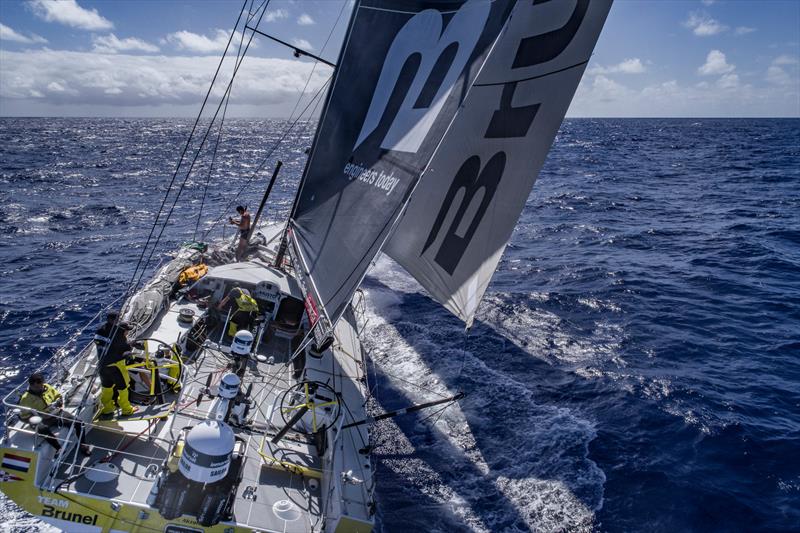
Volvo Ocean Race: The Leg 6 Casino opens in a couple of days
by Richard Gladwell, Sail-World.com/nz 14 Feb 2018 10:27 AEDT

Leg 6 to Auckland, Day 7 on board Brunel. Sail change. Drone. 13 February, © Yann Riou / Volvo Ocean Race
"If you're gonna play the game, boy, ya gotta learn to play it right.
"You got to know when to hold 'em, know when to fold 'em,
"Know when to walk away and know when to run.
"You never count your money when you're sittin' at the table.
"There'll be time enough for countin' when the dealin's done."
The lyrics of Kenny Roger's signature hit "The Gambler" can aptly be applied to Leg 6 of the Volvo Ocean Race.
While the immediate attention focuses on who is currently beating who as the fleet enjoys Tradewind sailing, but the wind cards on Leg 6 will be dealt many times the Leg, as the Volvo 65's traverse the newly created Sea of Frustration.
This area of calms and light winds extends for 15 degrees of latitude or 1100nm, from just south of the Solomon Islands to a few hundred miles short of North Cape - the northernmost point of New Zealand.
On the latest sched Volvo OR Race Control still has Team AkzoNobel leading by an 11nm margin over yesterday's leader, SHK Scallywag, and 50nm over the third placed Team Brunel which in turn leads the van of the fleet.
In normal circumstances that would be a useful working lead and with a modicum of luck would be sufficient to build out to a triple-digit lead and a leg victory.
Heading north on Leg 4, the Doldrums caused the fleet several days of frustration, and on the return journey, according to the routing function of Predictwind, will be relatively less stressful, and the fleet should have a quick passage.
However a day or two later the real race begins as the fleet have to negotiate the wake of Cyclone Gita and a sideswipe from a second cyclone which spins off into the Southern Ocean. The two cyclones create a massive area of light and fickle breezes. The wind vacuum expands behind Gita as the Cyclone moves closer to New Zealand.
The Predictwind routing using four weather feeds shows a typical pattern for this situation - with each feed showing a markedly different course - and with the past certainty that the weather files will change markedly with every update.
For the six-boat Volvo Ocean Race fleet, the exercise is even more fraught - with race management in their wisdom deciding that the fleet will only receive two feeds (GFS and ECMWF). This makes tactical navigation a very fraught exercise - with the real risk of positioning to take a course that appears to be a way through the light winds, only to find a weather update or two later that you are in exactly the wrong place.
Given that situation, most navigators will normally opt to sail down the Great Circle course being the shortest route to the finish, and just focus on boat speed and small course devastation to extract the most from the fickle breeze.
"There'll be time enough for countin' when the dealin's done."
Or in the case of Leg 6 of the Volvo Ocean Race, when the leaders approach the Northland coast of New Zealand.
For the crews, the arrival in Auckland on February 25/26 will never have been sweeter.